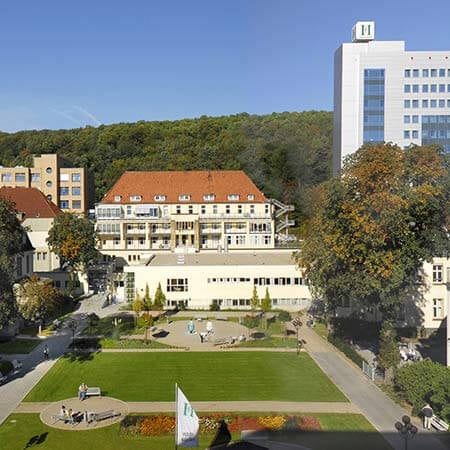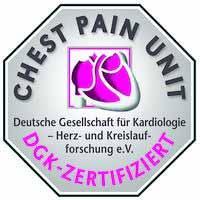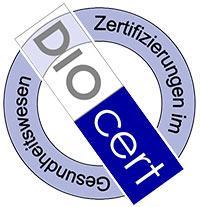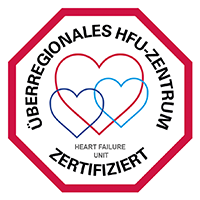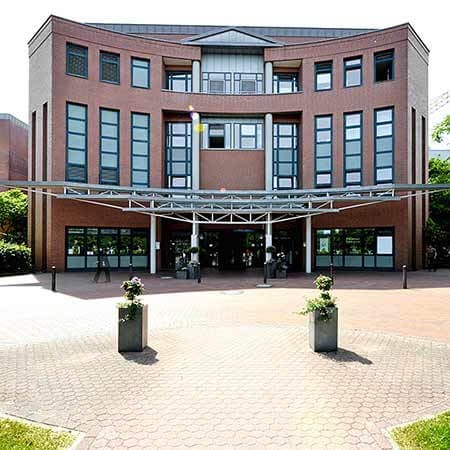Endocarditis is an inflammation of the inner lining of the heart. The pathology is life-threatening, often leading to heart valve disease, stroke, pulmonary embolism and other complications. Half of the patients require surgical treatment of the disease. You can undergo endocarditis treatment abroad, in one of the countries with advanced medicine. European specialists successfully cope with even the most severe cases of pathology. They cure endocarditis with antibiotics and then repair or replace damaged heart valves with prostheses.
Content
- Causes of endocarditis
- Risk factors
- Symptoms
- Diagnostics
- Treatment
- Conservative therapy
- Surgical intervention
- Why is it worth undergoing treatment for endocarditis abroad
- Treatment in Europe at an affordable price
Causes of endocarditis
In most patients with endocarditis, the inner lining of the heart is affected by an infectious disease. The causative agents can be streptococci, staphylococci and other bacteria. The most severe endocarditis is fungal. The prognosis is worse for patients with fungal endocardial inflammation, because they always require surgical treatment.
Other causes of endocarditis are as follows:
- Autoimmune inflammation.
- Blood clots in the heart.
- Hypereosinophilic syndrome.
Risk factors
The infection enters the heart from two sources: it is brought into the heart directly with a surgical instrument, or it comes from the blood.
Prosthetic valve endocarditis is an example of direct infection. Inflammation occurs after heart surgery.
Native valve endocarditis develops more often. The infection enters the bloodstream during injections, central vein catheterization, dental procedures. The risk of pathology is increased in injection drug addicts: their endocarditis is most often caused by Staphylococcus aureus living on the skin.
The following risk factors can cause the development of the pathology:
- HIV and other immunodeficiencies.
- Congenital heart defects.
- Elderly and senile age.
- Previous heart surgery and transcatheter procedures (valve replacement, pacemaker implantation).
- Cancer.
- Hypertrophic cardiomyopathy.
- Valvular heart disease.
The risk of endocarditis is higher for patients with previous endocardial inflammation. The probability of recurrent pathology during life reaches 5%.
Symptoms
The symptoms of the early stage of the disease are nonspecific. The most common manifestation is an increased body temperature. This symptom is detected in 90% of patients. Other signs are loss of appetite and weight loss.
The classic symptoms of endocarditis described in the literature develop only in advanced cases. These include:
- Appearance of seals on the fingers (Osler's node).
- Red palms and soles (Janevier symptom).
- Foci of hemorrhage in the eyes (Roth's spots) and under the nails.
Chest pain is not typical for endocarditis.
The following symptoms can be detected when examining a patient in a hospital:
- Heart murmur (caused by heart valve disease).
- Rapid pulse.
The first symptoms in many patients are neurological disorders caused by impaired cerebral circulation. Only after admission to a neurological hospital are they diagnosed with endocarditis.
In the natural course of the disease, if the patient does not seek medical help for a long time, endocarditis progresses rapidly. Within a few days, acute heart failure develops.
When the first symptoms appear, the patient should see a doctor as early as possible. As a rule, the patient is given antibiotic therapy immediately after admission to the hospital. After its initiation, the risk of complications of endocarditis is reduced by 2,5 times.
Diagnostics
The diagnosis of infective endocarditis is made according to Duke criteria. The diagnosis can be confirmed or probable. It is established on the basis of major and minor criteria. Endocarditis is considered confirmed with the following criteria available:
- Two major criteria.
- Three minors and one major.
- Five minor ones.
There are several options, when a doctor can diagnose possible infective endocarditis:
- One major and one minor criteria.
- Three minor ones.
There are only two major criteria:
- The blood culture reveals bacteria or fungi, which can be the causative agents of infective endocarditis.
- The instrumental tests detect the signs of endocardial lesions. The main methods are echocardiography (ultrasound examination) and computed tomography.
Minor Duke criteria:
- Сardiovascular diseases in the medical history, which are predisposing factors for the development of infectious inflammation of the endocardium.
- Multiple injections of medicines or drugs in the medical history.
- Fever over 38 degrees.
- Signs of autoimmune tissue inflammation.
- Microbes are sown from the blood, but in insufficient quantities to ascertain the presence of a major criterion.
- Any severe cardiovascular complications: stroke, pulmonary embolism, hemorrhage.
The instrumental diagnostics mostly involve the use of echocardiography. This is a safe examination without radiation exposure, which can be done every few days to monitor the patient's condition dynamically. Echocardiography is usually carried out through the chest. Less commonly, a transesophageal transducer is used. Such an examination causes discomfort in the patient, and therefore doctors in Europe perform it under drug sedation. Transesophageal ultrasound has a higher sensitivity – it reaches 95%. Doctors may find vegetations (growths on the heart valves) less than 5 mm in size.
Computed tomography can be used to diagnose the following conditions:
- Lesions of the coronary arteries.
- Complications of endocarditis – spleen infarction and stroke.
MRI is used to assess the state of the brain. 10% of patients with endocarditis have abscesses (purulent cavities), aneurysms or hemorrhages. Another 50% show signs of impaired blood supply to the brain, which are not accompanied by significant symptoms and do not lead to neurological deficit.
PET (positron emission tomography) is a clarifying diagnostic test, which is performed for suspected infective endocarditis.
An important role in diagnostics is also played by a microbiological examination. Doctors perform a blood culture to detect the causative agent of the infection, assess the number of bacteria and determine their sensitivity to various antibiotics. Culture results are diagnostic criteria and will influence the choice of treatment regimen.
Treatment
In European hospitals, the treatment of infective endocarditis is provided by a team of doctors comprised of a cardiologist, a cardiac surgeon, a specialist in infectious diseases, sometimes also a rheumatologist, a neurologist and a neurosurgeon (brain complications develop in one out of four patients with endocarditis). The management of patients by several doctors significantly improves the prognosis, and therefore such an approach is considered mandatory in developed countries.
The mainstay of treatment for infective endocarditis is antibiotic therapy. Even with successful suppression of the infection, approximately half of patients will require a surgical intervention.
Conservative therapy
The treatment of infective endocarditis involves the use of antibiotics. At first, it is empirical therapy, which means that doctors simply prescribe broad-spectrum medications that can destroy most of the most common causative agents of endocarditis.
After 2 days, the specialists in infectious diseases receive a medical report from the bacteriological laboratory. Now they not only know the causative agent of the infection, but also have data on the sensitivity of microorganisms to various antibiotics. After receiving these data, the antibiotic regimen can be adjusted.
Antibiotic therapy for endocarditis takes a long time. The medicines are not canceled 4-6 weeks after all symptoms have disappeared. If treatment is stopped earlier, endocarditis is very likely to recur.
Surgical intervention
Indications for surgery are as follows:
- Fungal etiology of the disease.
- Uncontrolled infection.
- Progression of the disease due to antibiotic therapy.
- Abscesses (cavities with pus) in the heart.
- Severe heart valve insufficiency affecting any valve.
- Prosthetic valve endocarditis.
Whenever possible, a heart surgical intervention is performed after elimination of the focus of infection and stabilization of the patient's condition. Ideally, patients are operated on 2 weeks after completing antibiotic therapy.
However, this is not always possible, since in some cases life-threatening conditions arise, which require emergency surgery. Some patients are operated on even on the first day after hospitalization. Emergency surgical interventions are not always successful and have a high risk of death. Therefore, they are resorted to only in extreme cases, such as severe acute heart failure, uncontrolled infection or the threat of cerebral embolism. Most emergency operations are performed for heart failure caused by destruction of the leaflets of the aortic or mitral valves.
The tasks of the surgeons are to eliminate inflammation and repair the heart valves. Doctors remove inflamed tissue in the heart. Small cavities with pus are cleaned and sutured, large abscesses are drained. A pathway is usually formed for the outflow of inflammatory fluid into the pericardial cavity.
The heart valves are repaired, and if reconstruction is not possible, then they are replaced with prostheses. As a rule, only mitral or tricuspid valves can be repaired. The aortic valve is more often damaged as a result of endocarditis and it cannot be reconstructed. It is replaced with a prosthesis.
The mitral and tricuspid valves are located between the atria and ventricles – in the left and right half of the heart, respectively. In case of endocarditis, the mitral valve is more often affected. Both valves can be repaired. Doctors suture the leaflets or perform flap plastic surgery. Sometimes chords open. These are tendon filaments, which hold the valve leaflets. In this case, they are repaired: the doctor places threads from artificial materials.
If it is impossible to restore the valves, they are replaced with prostheses. Young patients often suffer from endocarditis, so mechanical prostheses are often placed in the mitral position. They require lifelong anticoagulant therapy, but can serve up to 30 years, and sometimes longer. Predominantly biological prostheses are placed in the tricuspid position, since mechanical ones contribute to the formation of blood clots. Bioprostheses are not so durable. After 10-15 years, they may need to be replaced. However, surgeons in developed countries perform revision replacement surgery using a minimally invasive access: through the vessels in the leg.
Why is it worth undergoing treatment for endocarditis abroad
Endocarditis is a serious disease, the treatment of which requires experienced specialists and state-of-the-art medical technology. In this disease, the risk of complications from the central nervous system, including ischemic stroke, is 25%. About 10% of patients develop pulmonary embolism. The need for surgical treatment occurs in 50% of patients. The mortality rate of patients with infective endocarditis reaches 30%.
Developed countries have 2-3 times lower mortality rate. Doctors successfully cure endocarditis and eliminate its consequences. There are several reasons for you to undergo medical treatment abroad:
- Accurate diagnostics allows the doctors to determine the cause of endocarditis in order to ideally plan treatment.
- The patient is led not by one doctor, but by the "endocarditis team".
- The risk of death within 12 months is only 8%. The mortality rate of patients is 2 times lower than the world average and 4 times lower than in countries with poorly developed medicine.
- Successful performance of even emergency (on the first day) and urgent (in the first week) surgical interventions.
- Possible simultaneous replacement or reconstruction of several heart valves within a single surgical intervention.
- In 80% of cases, the mitral valve is repaired, rather than replaced with a prosthesis – this operation is technically more complex, but provides better long-term results.
- Revision replacement of the heart valves is performed with the use of minimally invasive methods: a new bioprosthesis is placed over the old one through an incision in the leg instead of open-heart surgery.
You can go to Europe not only for the treatment of endocarditis, but also to eliminate the consequences of the disease. The most common consequences are heart valve defects. They can be corrected on a scheduled basis, using surgical interventions or minimally invasive procedures.
Treatment in Europe at an affordable price
To undergo treatment in one of the European hospitals, you can use the services of the Booking Health specialists. On our website, you can see the cost of treatment in Europe, compare prices and book a medical care program at a favorable price. Treatment in Europe will be easier and faster for you, and the cost of treatment will be significantly lower.
You are welcome to leave your request on the Booking Health website. Our consultant will contact you within 24 hours. The medical tourism operator form the Booking Health company will organize your trip for medical treatment in Europe. We will provide the following benefits for you:
- We will choose a hospital for treatment in Europe, whose doctors specialize in the treatment of endocarditis and achieve the best results.
- We will help you overcome the language barrier and establish communication with your attending physician.
- We will reduce the waiting time for the medical care program. You will receive medical services on the most suitable dates.
- We will reduce the price. The cost of treatment in a European hospital will be lower due to the lack of overpricing and additional coefficients for foreign patients.
- We will solve all organizational issues, such as paperwork, booking a hotel room, transfer from the airport to the hospital. An interpreter will accompany you abroad.
- We will prepare a program and translate medical documents. You do not have to repeat the previously performed diagnostic procedures.
- We will help you keep in touch with the hospital after the completion of treatment in Europe.
- We will organize additional diagnostic examinations and treatment in a European hospital, if required.
- We will buy medicines abroad and forward them to your native country.
The world's leading doctors will take care of your health. The Booking Health specialists will help reduce the cost of treatment, organize your trip, and you will only have to focus on restoring your health.
Authors:
This article was edited by medical experts, board-certified doctors Dr. Nadezhda Ivanisova, and Dr. Bohdan Mykhalniuk. For the treatment of the conditions referred to in the article, you must consult a doctor; the information in the article is not intended for self-medication!
Our editorial policy, which details our commitment to accuracy and transparency, is available here. Click this link to review our policies.
